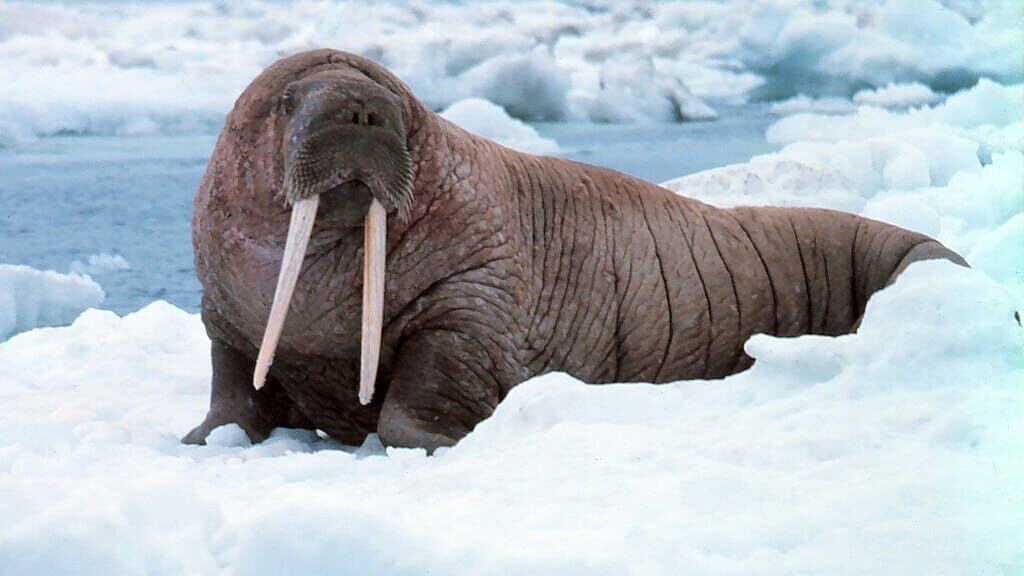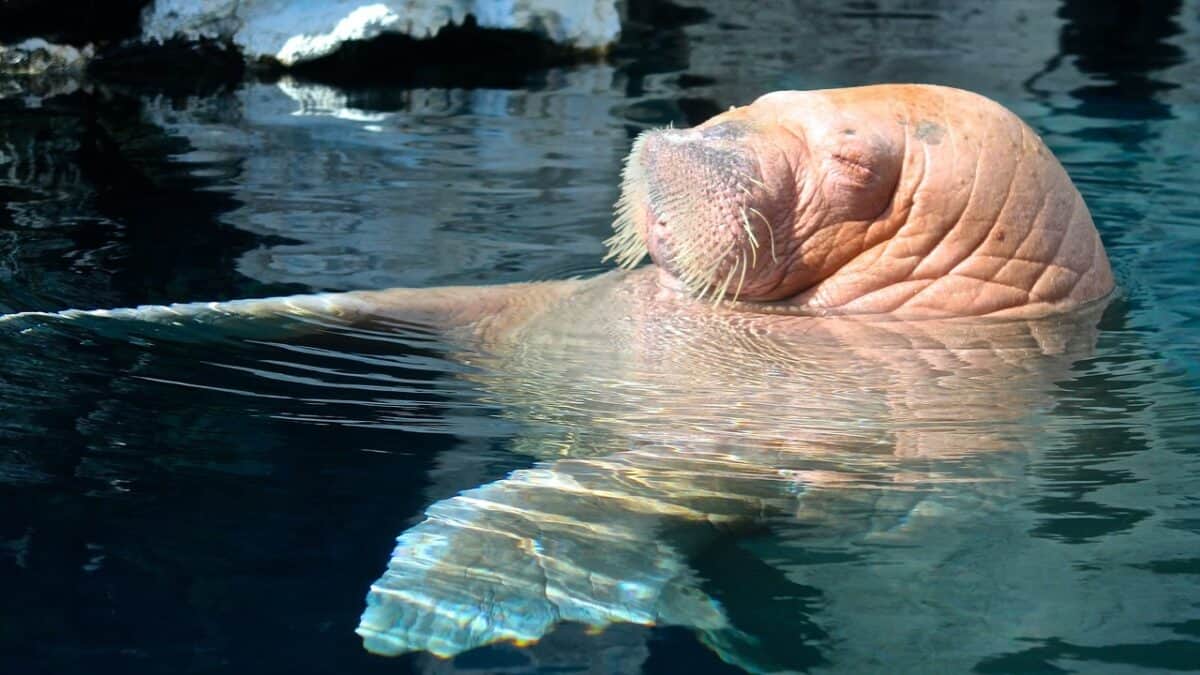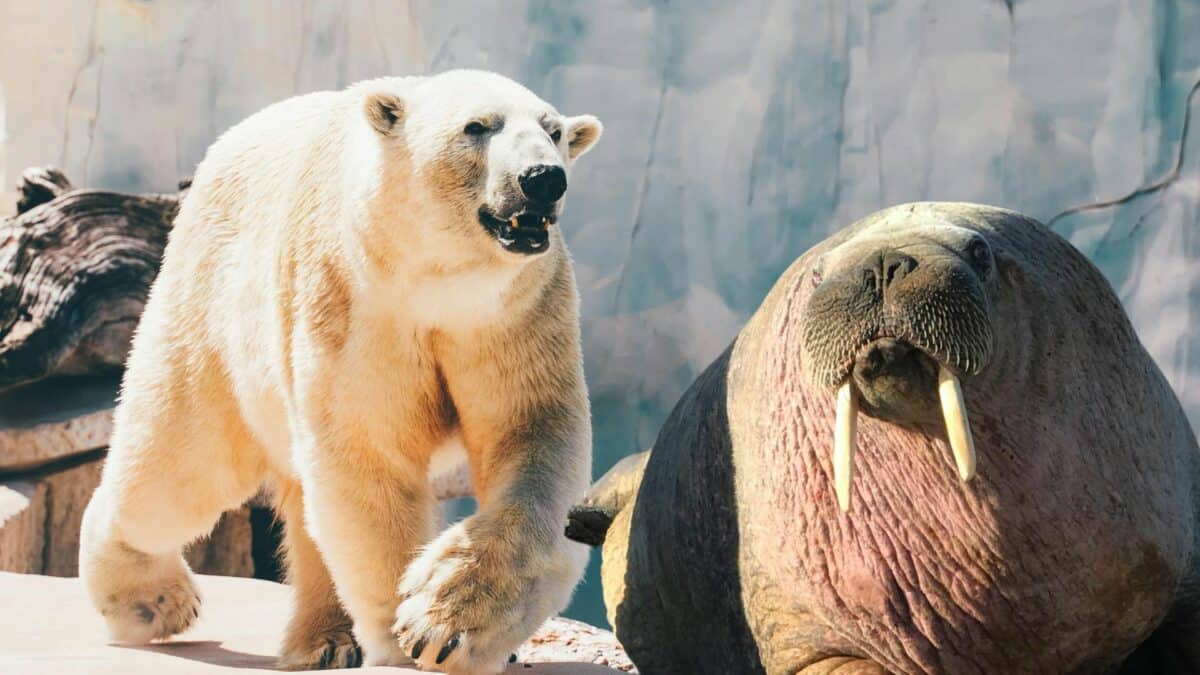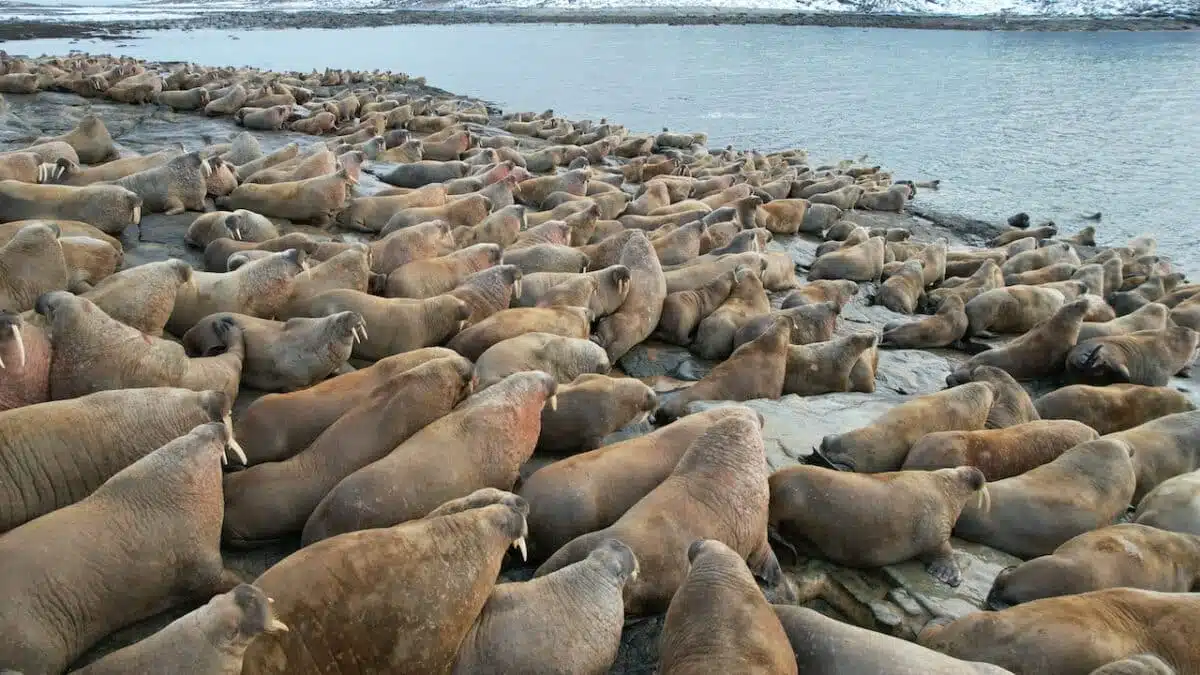The mighty walrus, with its impressive tusks extending from its face like natural ice picks, is one of the Arctic’s most distinctive marine mammals. These remarkable creatures have evolved specialized adaptations that help them survive in one of Earth’s harshest environments. Among their most notable features are their elongated canine teeth—their tusks—which serve multiple crucial functions beyond mere display. While many might assume these impressive ivory structures are primarily weapons, walruses have developed ingenious ways to use their tusks as tools for navigating their icy habitat. From hauling their massive bodies onto ice floes to creating breathing holes and even searching for food, walrus tusks are versatile instruments essential for survival in the frozen north. This fascinating adaptation represents one of nature’s most creative solutions to the challenges of Arctic living.
The Anatomy of Walrus Tusks

Walrus tusks are actually elongated canine teeth that can grow to impressive lengths—sometimes reaching up to 3 feet (1 meter) in males and about 1.5 feet (0.5 meters) in females. These tusks continue growing throughout the walrus’s lifetime, which can span 40 years or more. Composed primarily of dentine and covered with a thin layer of cementum, rather than enamel like most mammalian teeth, these structures are both strong and slightly flexible—an important quality for their various uses.
What makes walrus tusks particularly special is their internal structure. They contain an inner core of pulp surrounded by layers of dentine, giving them remarkable strength while maintaining some flexibility. This composition allows walruses to put considerable pressure on their tusks without breaking them. Unlike elephant tusks, which are solely composed of dentine without nerve endings, walrus tusks contain nerves that provide sensory feedback when they’re being used, allowing for more precise movements when navigating ice.
Ice Climbing: Hauling Massive Bodies Onto Frozen Surfaces

Perhaps the most well-documented use of walrus tusks is for hauling their enormous bodies—which can weigh up to 1.5 tons (1,360 kg)—out of water and onto ice floes. This process resembles ice climbing, with walruses using their tusks as natural ice picks. When approaching an ice edge, a walrus will swim up to the surface, thrust its tusks into the ice, and use them as anchors to pull its massive body up and out of the water. This technique requires tremendous upper body strength combined with the leverage provided by their tusks.
The process is particularly impressive when you consider that walruses are primarily aquatic mammals that need to exit the water regularly to rest. Without their tusks, climbing onto ice—especially slippery, unstable ice floes—would be nearly impossible given their body shape and weight. Researchers have observed that walruses will often test ice with their tusks before attempting to haul out, seemingly gauging whether the ice will support their weight. This behavior demonstrates the critical importance of tusks for basic mobility in their Arctic habitat.
Creating Breathing Holes in Thick Ice

During winter months when the Arctic Ocean freezes over, walruses face the challenge of maintaining access to air while foraging beneath the ice. They cleverly use their tusks to create and maintain breathing holes in ice that might otherwise be too thick to break through with their heads alone. By repeatedly striking upward with their tusks, walruses can fracture ice from below, creating vital air access points that allow them to venture farther from the ice edge while foraging.
This ability to create breathing holes significantly expands their winter foraging range and provides emergency air access when needed. Young walruses with shorter tusks or females with smaller tusks often benefit from these breathing holes created by larger males. Scientists studying walrus behavior have noted that these breathing holes are sometimes maintained collectively by groups of walruses, showing how this tusk-based adaptation supports not just individual survival but also community resilience in harsh Arctic conditions.
Anchoring in Strong Currents

Arctic waters are known for their strong and unpredictable currents, which can make feeding difficult for bottom-dwelling foragers like walruses. To counter these forces, walruses ingeniously use their tusks as anchors when feeding on the seafloor. By hooking one or both tusks into the substrate, they can maintain their position against currents while using their sensitive whiskers (vibrissae) to locate prey items like clams, mussels, and other shellfish buried in the sediment.
This anchoring technique is particularly important because walruses feed primarily by suction. They create powerful vacuum-like pressure with their mouths to extract soft-bodied invertebrates from their shells. Without the stability provided by their tusks, this feeding method would be significantly less efficient in areas with strong water movement. Underwater footage has shown walruses demonstrating remarkable dexterity with their tusks, adjusting their anchoring position as needed to maximize feeding efficiency while conserving energy—a critical consideration in the cold Arctic environment.
Social Hierarchy and Dominance Displays

While tusks serve numerous practical functions, they also play a crucial role in establishing and maintaining social hierarchies within walrus groups. Male walruses, in particular, use their tusks in dominance displays during mating season. The size and condition of a male’s tusks signal his age, health, and fighting capability to potential rivals. Larger, more symmetrical tusks generally indicate a dominant male who has successfully survived many seasons and likely has good genes to pass on.
Actual physical confrontations involving tusks are relatively rare, as most dominance issues are settled through display behaviors rather than combat. Males will posture with their heads held high, showing off their tusks’ full length and girth. They may also engage in tusk clashing—a behavior where they strike their tusks together, creating loud sounds that reverberate through both air and water. These displays help establish breeding hierarchies without the need for potentially dangerous physical confrontations, demonstrating how tusks function both as tools and as social signals.
Breaking Through Sea Ice From Below

One of the most impressive demonstrations of tusk strength comes when walruses need to break through ice from underneath. When swimming beneath relatively thin ice (up to about 8 inches or 20 cm thick), walruses can use their tusks as battering rams, repeatedly striking upward until they create a hole large enough to surface and breathe. This ability can be lifesaving in emergency situations where they need to surface quickly but find themselves under an ice sheet.
Scientists have measured the force walruses can generate with their tusks during these breaking attempts, finding they can exert over 2,000 pounds (907 kg) of pressure in a concentrated strike. This remarkable power comes from the walrus’s strong neck muscles combined with their ability to accelerate quickly underwater. The slightly curved shape of the tusks also helps concentrate force at their tips, making them more effective at cracking ice. This adaptation allows walruses to access areas that would otherwise be inaccessible during partially frozen periods, expanding their habitat range significantly.
Digging for Food in Seafloor Sediment

Walruses are primarily benthic feeders, meaning they forage for food on the ocean floor. Their diet consists mainly of mollusks, particularly clams, which are often buried several inches deep in sediment. To access these hidden food sources, walruses employ their tusks as digging tools. By making sweeping motions with their heads, they use their tusks to plow through mud and sand, exposing prey that would otherwise remain hidden.
Research using underwater cameras has shown that walruses also use their tusks to dislodge larger items from the seafloor, such as rocks that might be hiding prey underneath. They display remarkable precision in these movements, coordinating their tusk use with their sensitive whiskers, which contain numerous nerve endings that can detect prey even in murky, disturbed sediment. This feeding strategy is incredibly efficient, with a single walrus capable of consuming thousands of clams in one feeding session. Analysis of walrus tusks often shows wear patterns consistent with this digging behavior, particularly on the outer edges and tips.
Defending Against Predators

While adult walruses have few natural predators due to their size, they still face threats from polar bears and killer whales. In these dangerous encounters, tusks serve as formidable defensive weapons. When threatened by polar bears on ice, walruses form protective circles around their young, positioning themselves with tusks facing outward. The sight of dozens of sharp tusks pointing in their direction is often enough to deter even hungry polar bears from attacking.
In water, where killer whales pose the primary threat, walruses use their tusks differently. They may attempt to strike at attacking orcas or use their tusks to quickly haul out onto ice floes where killer whales cannot follow. Researchers have documented scarring patterns on killer whales believed to be from walrus tusk encounters, suggesting that these defensive tactics can be effective. For young walruses with undeveloped tusks, the protection of the herd is essential, as they are particularly vulnerable until their own tusks grow to functional size—typically after several years of development.
Tusks as Multi-Sensory Tools

Unlike many other tusked animals, walrus tusks contain nerve endings that provide sensory feedback. This neurological connection allows walruses to use their tusks not just as mechanical tools but as sensory organs that provide information about their environment. When a walrus strikes ice with its tusks, it can feel vibrations and assess the ice’s thickness and stability. This sensory capability helps them make critical decisions about whether ice is safe to haul out onto or too thin to support their weight.
The sensory function of tusks also plays a role in social interactions. When walruses engage in tusk-to-tusk contact during social bonding or dominance displays, they can feel pressure and vibrations through their tusks. Some researchers believe this may be part of how they communicate and establish relationships within their social groups. This combination of mechanical utility and sensory capability makes walrus tusks uniquely sophisticated among mammalian tooth adaptations, representing a remarkable example of evolutionary specialization for life in the Arctic.
The Impact of Climate Change on Tusk Functionality

As Arctic sea ice diminishes due to climate change, walruses face new challenges that affect how they use their tusks. Traditionally, walruses would rest on sea ice between feeding bouts, using their tusks to haul out onto floating ice platforms. With less sea ice available, especially in summer months, walruses are increasingly forced to haul out on land in massive aggregations that can number in the thousands. This change means they’re using their tusks to climb rocky shores rather than ice—a surface for which their tusks are less perfectly adapted.
These land-based haul-outs create dangerous conditions, particularly for younger walruses. When spooked, these massive groups can stampede toward the water, and walruses without fully developed tusks may be crushed in the chaos. Additionally, the longer treks between terrestrial resting areas and offshore feeding grounds require more energy, potentially putting additional stress on walruses already coping with a changing ecosystem. Scientists monitoring these adaptations have noted increased tusk breakage in populations using rocky haul-outs frequently, suggesting that these new behaviors may be physically costly for an animal evolved to use its tusks primarily on ice.
Evolutionary Development of Tusk Use

The walrus’s specialized use of tusks as ice picks didn’t develop overnight but rather evolved over millions of years as these marine mammals adapted to Arctic conditions. Fossil evidence suggests that ancient walrus ancestors had more conventional teeth, and the extreme elongation of canines into tusks developed gradually as they specialized for life in icy environments. This evolutionary pathway demonstrates how natural selection favored individuals with longer, stronger canines that could better navigate ice surfaces.
Interestingly, genetic studies indicate that the genes responsible for tusk development in walruses have undergone significant positive selection, meaning these traits were strongly favored by natural selection. Researchers can actually see evidence of this evolutionary pressure in the walrus genome. The remarkable aspect of this adaptation is how a structure that began as a tooth for processing food transformed into a multi-purpose tool essential for mobility, feeding, and social interaction. Few other examples exist in nature where a single anatomical feature serves so many distinct and vital functions for a species’ survival.
Walrus tusks represent one of nature’s most impressive examples of evolutionary adaptation, transforming what began as simple teeth into multi-functional tools essential for survival in the harsh Arctic environment. These remarkable structures allow walruses to navigate their icy world, from hauling their massive bodies onto ice floes to creating breathing holes and efficiently harvesting food from the ocean floor. The sensitivity and strength of walrus tusks provide these marine mammals with capabilities that would be impossible to replicate through any other adaptation, making them perfectly suited to their ecological niche.
As climate change continues to transform the Arctic, the future of walruses and their specialized tusk use faces uncertainty. Will these adaptations that evolved for an ice-dominated environment continue to serve walruses well in warming seas with diminishing ice cover? Only time will tell, but the remarkable versatility these animals have already demonstrated suggests resilience. The story of walrus tusks reminds us of nature’s ingenious solutions to environmental challenges and the importance of preserving the delicate Arctic ecosystems where these extraordinary adaptations evolved. Through continued research and conservation efforts, we can help ensure that walruses will continue to use their impressive tusks as ice picks for generations to come.
- 13 Most Loyal Dog Breeds in the World - August 10, 2025
- Why Some Mammals Hibernate Without Ever Freezing - August 10, 2025
- 12 Snake Species That Can Kill in One Bite - August 10, 2025

